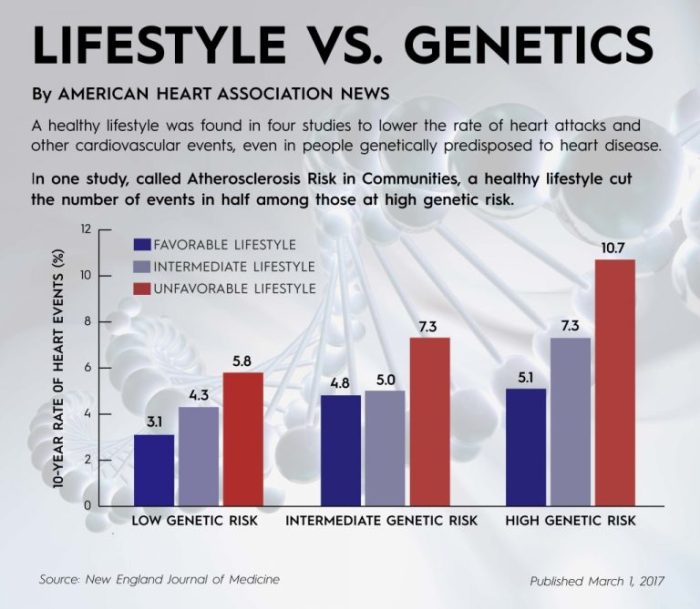Delving into the realm of Low-Risk Lifestyle Choices and Coverage Benefits, this paragraph sets the stage for a comprehensive exploration of how our daily decisions can impact our well-being and financial security. Get ready to uncover the link between lifestyle choices and insurance coverage in a captivating narrative.
As we dive deeper into the benefits and implications of adopting low-risk lifestyle choices, a world of possibilities opens up for a healthier and more financially stable future.
Benefits of Low-Risk Lifestyle Choices
Living a lifestyle that involves low-risk choices offers numerous benefits that can positively impact overall well-being. By making conscious decisions to prioritize health and safety, individuals can significantly reduce the likelihood of facing various health issues and improve their quality of life.
Examples of Low-Risk Lifestyle Choices
- Regular exercise: Engaging in physical activity not only helps maintain a healthy weight but also reduces the risk of chronic diseases such as heart disease, diabetes, and certain types of cancer.
- Healthy eating habits: Consuming a balanced diet rich in fruits, vegetables, whole grains, and lean proteins can boost immunity and support overall health.
- Adequate sleep: Getting enough rest is essential for cognitive function, mood regulation, and overall well-being.
- Avoiding tobacco and excessive alcohol consumption: Steering clear of harmful substances can prevent a wide range of health issues and improve longevity.
- Managing stress: Practicing relaxation techniques such as meditation, yoga, or deep breathing can reduce the negative effects of stress on both the body and mind.
Positive Impact of Low-Risk Lifestyle Choices
Low-risk lifestyle choices not only reduce the chances of developing chronic conditions but also enhance physical fitness, mental health, and overall quality of life. By making these choices a priority, individuals can experience increased energy levels, improved mood, better sleep, and a reduced risk of premature death.
Embracing a low-risk lifestyle can lead to a longer, healthier, and more fulfilling life.
Coverage Benefits of Low-Risk Lifestyle Choices
Low-risk lifestyle choices can have a significant impact on insurance coverage. Insurance companies typically view individuals with low-risk lifestyles as less likely to make claims, leading to lower premiums and better coverage options.
Potential Discounts and Special Coverage Options
Insurance companies often offer discounts or special coverage options to individuals with low-risk lifestyles. These can include lower premiums, higher coverage limits, or additional benefits such as wellness programs or preventive care services.
- Discounted Premiums: Insurers may offer reduced premiums to individuals who maintain a healthy lifestyle, such as non-smokers, regular exercisers, or those with a balanced diet.
- Higher Coverage Limits: Individuals with low-risk lifestyles may qualify for higher coverage limits on their policies, providing greater financial protection in case of unexpected events.
- Wellness Programs: Some insurance companies offer wellness programs to promote healthy living and prevent future health issues, providing incentives for policyholders to maintain their low-risk lifestyle.
- Preventive Care Services: Special coverage options may include preventive care services like screenings, vaccinations, or health check-ups to help individuals maintain their well-being and avoid potential health risks.
Tips for Maintaining a Low-Risk Lifestyle
Living a low-risk lifestyle is essential for optimal health and safety. By incorporating simple choices into your daily routine, you can significantly reduce the risks to your well-being. Here are some practical tips to help you maintain a low-risk lifestyle:
Regular Exercise
Regular physical activity is key to maintaining a low-risk lifestyle. Aim for at least 30 minutes of exercise most days of the week. This can include activities like walking, jogging, swimming, or yoga. Find an activity you enjoy to make it easier to stick to a routine.
Healthy Eating Habits
Eating a well-balanced diet rich in fruits, vegetables, whole grains, and lean proteins is crucial for overall health. Limit your intake of processed foods, sugary drinks, and unhealthy fats. Remember to stay hydrated by drinking plenty of water throughout the day
Manage Stress
Chronic stress can have a negative impact on your health. Find healthy ways to manage stress, such as meditation, deep breathing exercises, or spending time outdoors. Make time for activities you enjoy and prioritize self-care to reduce stress levels.
Sleep Well
Quality sleep is essential for overall well-being. Aim for 7-9 hours of sleep each night to allow your body to rest and recharge. Create a relaxing bedtime routine and ensure your sleeping environment is conducive to a good night's rest.
Regular Health Check-ups
Don't skip your regular health check-ups and screenings. Early detection of health issues can lead to better outcomes. Stay up to date with vaccinations, screenings, and preventive care recommended by your healthcare provider.
Financial Implications of Low-Risk Lifestyle Choices

Maintaining a low-risk lifestyle not only benefits your health but also has positive financial implications. By making smart choices that reduce the risk of accidents, illnesses, or other costly events, individuals can save money in the long run and improve their financial well-being.
Impact on Financial Savings
- Lower Insurance Premiums: Adopting low-risk behaviors such as regular exercise, a balanced diet, and avoiding smoking can lead to lower health insurance premiums. Insurance companies often reward individuals who are less likely to make claims.
- Reduced Healthcare Costs: By staying healthy and preventing chronic conditions through a low-risk lifestyle, individuals can save on medical expenses, including doctor visits, medications, and treatments.
- Less Need for Emergency Funds: Lowering the risk of unexpected accidents or health issues reduces the need for emergency funds, allowing individuals to allocate their money towards savings or investments instead.
Long-Term Financial Planning
- Retirement Savings: By maintaining a low-risk lifestyle and avoiding costly health issues, individuals can better prepare for retirement by saving more and investing wisely for the future.
- Financial Stability: Reduced financial stress from medical bills or emergencies allows individuals to focus on building a solid financial foundation, including saving for education, homeownership, or other long-term goals.
Examples of Financial Benefits
- Case Study: Sarah, who follows a low-risk lifestyle with regular exercise and healthy eating, saves $500 annually on health insurance premiums compared to her peers with riskier habits.
- Research Findings: Studies show that individuals who engage in low-risk behaviors like wearing seat belts, practicing safe driving, and maintaining a healthy weight experience lower healthcare costs over their lifetime.
Final Conclusion
In conclusion, Low-Risk Lifestyle Choices and Coverage Benefits offer a path towards a more secure and fulfilling life. By making informed decisions and prioritizing health and safety, we can pave the way for a brighter tomorrow.
Helpful Answers
How can low-risk lifestyle choices impact insurance premiums?
Insurance companies often reward individuals with low-risk lifestyles by offering lower premiums as they are considered less likely to make claims.
What are some examples of low-risk lifestyle choices?
Examples include regular exercise, balanced diet, avoiding smoking, limiting alcohol intake, and practicing safe driving habits.
Can low-risk lifestyle choices lead to long-term financial savings?
Absolutely. By maintaining a low-risk lifestyle, individuals can reduce medical expenses, insurance costs, and improve overall financial stability in the long run.






